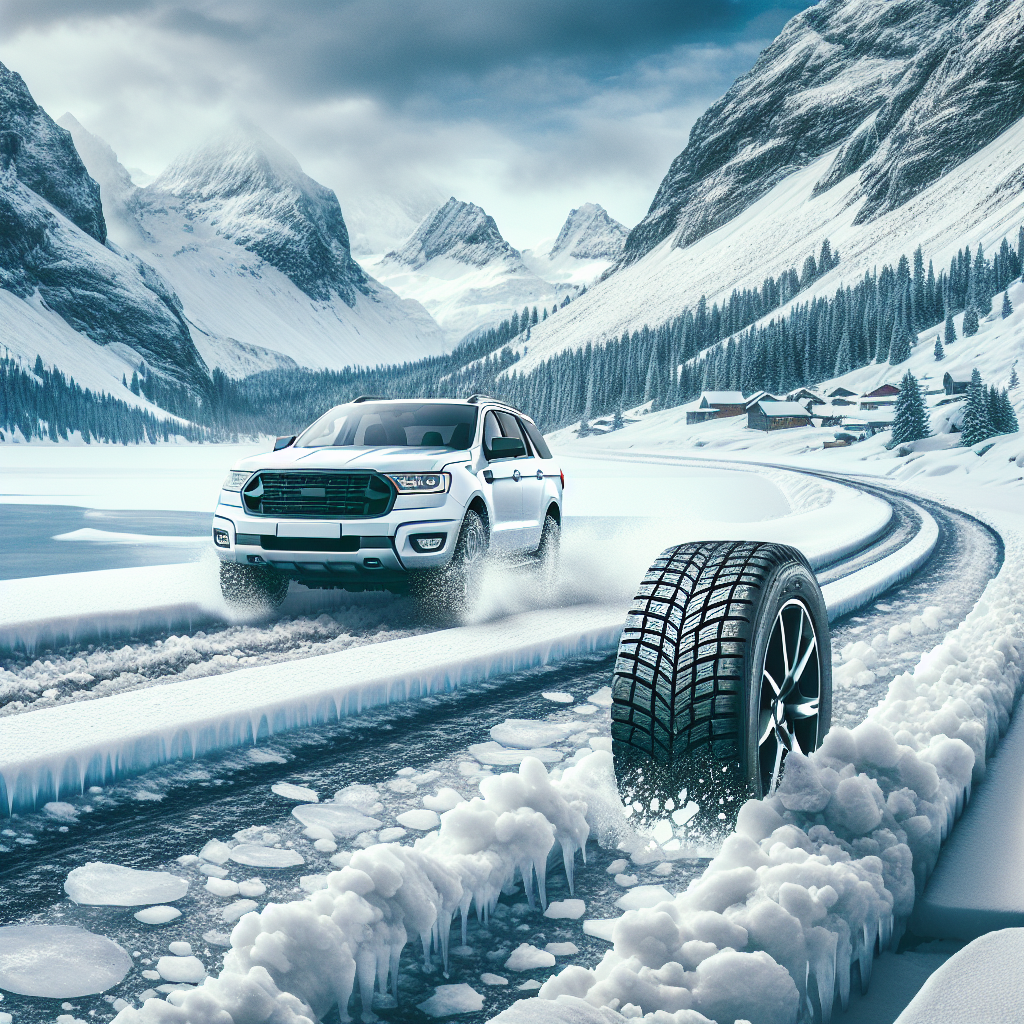You’re gearing up for winter, and as you navigate the icy roads ahead, you’re wondering how your winter tires will perform. Will they provide the necessary traction to keep you safe on those treacherous icy patches and black ice? In this article, we’ll explore just that – the capabilities of winter tires and how they handle these slippery conditions. So, buckle up and get ready for a ride filled with valuable insights that will ease your winter driving worries.
The Importance of Winter Tires
Winter is a beautiful season filled with snow-covered landscapes and cozy nights by the fireplace. However, it also brings about a whole new set of challenges when it comes to driving. As the temperature drops, the road conditions become more treacherous, making it imperative to equip your vehicle with winter tires. These specialized tires are designed to provide enhanced safety and performance in winter conditions, including icy patches and black ice. In this article, we will explore the various aspects of winter tires and how they can help you navigate through these challenging road situations.
Enhanced Safety in Winter Conditions
Winter tires are specifically engineered to maximize safety on slippery and icy roads. One of the key factors contributing to their superior performance is the tire tread design.

Tire Tread Design
The tread design of winter tires plays a crucial role in providing optimal traction and grip on icy surfaces. These tires feature deep tread patterns, which allow for enhanced traction by effectively gripping the road surface.
Deep Tread Patterns
Winter tires are equipped with deep tread patterns that have wider and deeper grooves compared to all-season tires. These grooves are designed to channel away slush, snow, and water from the tire’s contact patch, which helps to minimize the risk of hydroplaning and maintain a firm grip on the road.
Sipes and Lamellae
Another important aspect of winter tire tread design is the presence of sipes and lamellae. Sipes are small slits in the tread blocks, while lamellae are thin cuts across the tire tread surface. These features help to create additional biting edges and improve traction on icy surfaces.
Grooves and Channels
Winter tires also incorporate grooves and channels in their tread design to facilitate efficient evacuation of water, slush, and snow. By effectively channeling these elements away from the tire surface, winter tires are able to maintain contact with the road, reducing the risk of hydroplaning and enhancing overall grip.
Handling Icy Patches
Icy patches on the road can be particularly dangerous, causing your vehicle to lose traction and slide unpredictably. Winter tires offer several advantages when it comes to handling these treacherous conditions.
Improved Traction
Winter tires are specifically designed to provide improved traction on icy surfaces. The deep tread patterns and sipes of these tires allow them to bite into the ice, providing better grip and reducing the likelihood of slipping and sliding.
Reduced Slipping and Sliding
The aggressive tread design of winter tires significantly reduces the chances of slipping and sliding on icy patches. The deep grooves and channels help to quickly evacuate the water and slush, allowing the tires to maintain consistent contact with the road surface and enhancing stability.
Enhanced Braking Performance
Braking on icy patches can be a nerve-wracking experience, as it often takes longer to come to a complete stop. Winter tires offer enhanced braking performance by providing better grip and traction. With their specialized tread design and rubber compound, these tires allow for shorter braking distances, giving you more control over your vehicle in icy conditions.

Dealing with Black Ice
Black ice is a hidden danger that can catch even the most experienced drivers off guard. It is a thin layer of ice that forms on the road surface, often appearing transparent and blending with the asphalt. Winter tires offer specific advantages when it comes to driving on black ice.
Limited Traction
Black ice is known for its extremely slippery nature, often rendering the road surface almost devoid of any traction. Winter tires provide a better chance of maintaining some traction on black ice due to their specialized tread design, which allows for increased contact with the road surface.
Smoother Road Contact
The deep tread patterns of winter tires help to ensure smoother contact with the road, even on black ice. By dispersing the thin layer of water that forms on the ice, these tires enhance grip and stability, reducing the risk of sliding or losing control.
Steady and Smooth Driving
The superior traction provided by winter tires on black ice allows for a more steady and controlled driving experience. With their specialized design and optimized grip, these tires help to mitigate the unpredictable nature of black ice, enabling you to navigate such treacherous conditions with confidence.
Maintaining Control
While winter tires significantly improve your safety on icy patches and black ice, it is important to remember that they are not a magic solution. Regardless of the tires you have, there are driving techniques that can help you maintain control in winter conditions.
Attention to Deceleration
When driving on slippery surfaces, it is crucial to pay attention to deceleration. Begin slowing down well in advance and give yourself ample time to come to a complete stop. This precautionary measure helps to avoid sudden movements and allows the tires to maintain grip on the road.
Avoiding Abrupt Steering
Abrupt or sudden steering inputs can cause your vehicle to lose traction and slide. To prevent this, it is important to make smooth and gradual steering adjustments. This allows the tires to maintain contact with the road surface and reduces the risk of losing control.
Prevention of Overconfidence
It’s easy to become overconfident when driving with winter tires, as they provide significant improvements in traction and handling. However, it is vital to remember that winter tires are not invincible. It is crucial to drive responsibly, adhere to speed limits, and always be aware of the changing road conditions, even with the added safety of winter tires.

Driving Techniques
In addition to maintaining control, there are several driving techniques that can further enhance your safety on winter roads.
Maintaining Safe Speed
Driving at an appropriate speed for the conditions is crucial in winter weather. It is important to lower your speed and adjust it according to the road conditions, including icy patches and black ice. By keeping a safe and manageable speed, you allow your winter tires to perform optimally and ensure better control over your vehicle.
Maintaining Safe Distance
Maintaining a safe distance between your vehicle and the one ahead is essential in winter conditions. The increased stopping distances on slippery roads require more time to react and come to a stop. By keeping a safe distance, you reduce the risk of rear-ending another vehicle and allow yourself ample time to respond to any unexpected situations.
Gentle Acceleration and Deceleration
Applying smooth and gradual accelerations and decelerations is key to maintaining control in winter conditions. Sudden movements can cause your tires to lose grip and traction, leading to sliding or spinning out of control. By applying gentle and controlled inputs, you allow your winter tires to maintain better contact with the road surface and ensure stability.
Winter Tires vs. All-Season Tires
When it comes to winter driving, the choice between winter tires and all-season tires is an important one. While all-season tires are designed to perform adequately in various weather conditions, they are not specifically optimized for the challenges of winter driving. Winter tires offer several advantages over all-season tires.
Cold Weather Performance
Winter tires are specifically designed to perform in cold weather conditions, while all-season tires start to lose their effectiveness as the temperature drops. The rubber compound of winter tires remains pliable in colder temperatures, providing better traction and grip on icy and slippery surfaces.
Tire Rubber Composition
The rubber composition of winter tires differs from that of all-season tires. Winter tires use a rubber compound that stays softer and more flexible in cold temperatures, allowing for improved grip and better contact with the road surface.
Differences in Tread Design
Winter tires and all-season tires have significant differences in tread design. Winter tires feature deeper treads, aggressive patterns, and additional sipes and lamellae, specifically designed to maximize traction on snowy and icy surfaces. All-season tires, on the other hand, have a more moderate tread design that seeks to strike a balance between various weather conditions.

Proper Winter Tire Maintenance
To ensure the optimal performance and longevity of your winter tires, proper maintenance is essential.
Tire Pressure Monitoring
Regularly monitoring the tire pressure of your winter tires is crucial. Cold temperatures can cause tire pressure to drop, affecting performance and safety. It is important to keep your tires properly inflated according to the manufacturer’s recommendations.
Regular Inspection for Wear
Inspecting your winter tires for wear and damage is vital for maintaining their performance. Look for signs of uneven wear, cuts, bulges, or punctures. If any issues are detected, it is important to have them addressed promptly to ensure optimal performance.
Rotation and Balancing
Rotating and balancing your winter tires at regular intervals helps to ensure even wear and prolong their lifespan. This maintenance practice also promotes optimal traction and handling, allowing your tires to perform at their best throughout the winter season.
Road Conditions and Tire Performance
Different road conditions require specific considerations when it comes to tire performance. Winter tires offer superior performance in a variety of challenging winter road conditions.
Icy Road Surfaces
Winter tires excel on icy road surfaces due to their specialized tread design and rubber composition. The deep treads and aggressive patterns help to grip icy surfaces, providing improved traction and reducing the risk of slipping or skidding.
Snow-Covered Roads
Driving on snow-covered roads can be challenging, but winter tires are specifically designed to handle such conditions. The deep treads of these tires help to bite into the snow, providing enhanced traction and better control over your vehicle.
Wet and Slushy Conditions
Winter tires are also effective on wet and slushy roads. The grooves and channels in their tread design help to quickly evacuate water and slush, reducing the risk of hydroplaning and maintaining proper contact with the road surface.

Conclusion
Winter tires are an essential investment for anyone facing icy patches and black ice during the winter season. Their specialized tread design, improved traction, and optimized grip provide enhanced safety and performance in challenging winter conditions. By choosing winter tires, practicing responsible driving techniques, and properly maintaining your tires, you can navigate through winter roads with confidence, ensuring your safety and the safety of others. Stay safe and enjoy the winter wonderland with the peace of mind that winter tires bring.

